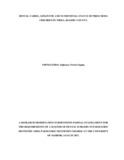| dc.contributor.author | Ogada., Alphonce O | |
| dc.date.accessioned | 2019-01-18T13:11:44Z | |
| dc.date.available | 2019-01-18T13:11:44Z | |
| dc.date.issued | 2018 | |
| dc.identifier.uri | http://hdl.handle.net/11295/105111 | |
| dc.description.abstract | Introduction:
WHO 1948 defined health as complete wellness state including physical, mental and social parameters. Nutritional status of children has a major role in their growth and development. This study sought to establish whether there is a relationship between certain nutritional parameters and oral diseases (caries and gingivitis) in preschool children.
Study objective: To determine the prevalence of dental caries and gingivitis in relation to nutritional status of children aged 36-59 months in Thika, Kiambu County.
Setting: Eight randomly selected preschools in Thika sub County, Kiambu County.
Study design: This was a cross sectional study of children aged 36-59 months in Kiambu County.
Results: 295 children were included in the study, giving a response rate of 77.6%. 142 (48.1%) were males while the remaining 153 (51.9%) were females. The ages ranged between 36-59 months with a mean age of 48.36 months (SD 7.06). The prevalence of gingivitis was 79.0% (n=233), 115 (49.4%) were males and 118 (50.6%) were females. The prevalence of dental caries was 62.7% (n=185), 100 (54.1%) were females while 85 (45.9%) were males. The dmft among the participants ranged from 0 to 18 with a mean of 3.19 (SD 3.96). There was a statistically significant relationship between frequency of tooth cleaning and use of tooth paste with dental caries prevalence among the participants. There was a statistically significant relationship between dental caries prevalence and at-will breastfeeding during the night. Children with low weight for age, low height for age and low weight for height accounted for 1.7%, 2.5% and 1.1% of the total population respectively. The relationship
between all nutritional parameters and the prevalence of dental caries and gingivitis was not significant.
Conclusion: There is no relationship between nutritional status, prevalence of dental caries and gingivitis among children aged 36-59 months.
Recommendations: There is need for education on oral hygiene and diet with emphasis on maternal breast feeding practices in order to reduce the prevalence of dental caries and gingivitis among children aged 36-59 moths. There is need for improvement on availability and accessibility to preventive and curative dental services in order to combat the dental diseases which are on the rise among children aged 36-59 months. Further research with larger sample size to gather more knowledge on the relationship between nutritional status and dental diseases in children is recommended | en_US |
| dc.language.iso | en | en_US |
| dc.publisher | University of Nairobi | en_US |
| dc.rights | Attribution-NonCommercial-NoDerivs 3.0 United States | * |
| dc.rights.uri | http://creativecommons.org/licenses/by-nc-nd/3.0/us/ | * |
| dc.title | Dental Caries, Gingivitis and Nutritional Status of Preschool Children in Thika, Kiambu County. | en_US |
| dc.type | Thesis | en_US |
| dc.description.department | a
Department of Psychiatry, University of Nairobi, ; bDepartment of Mental Health, School of Medicine,
Moi University, Eldoret, Kenya | |



